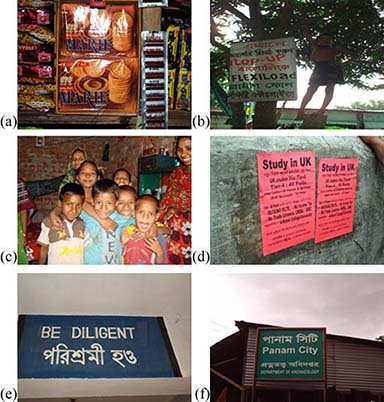1 What is everyday English?
You will start by thinking about what ‘everyday English’ is and how you can access this as a resource in your community.
Activity 1: What is everyday English?
In India, most communities use several languages. This means that many students come to school speaking more than one language. Because of the presence of English in our societies, students may also regularly use some English words in their day-to-day talk, even though they may not be aware that these words are English.
In our everyday language we often use English words for common objects and activities. For example, those of us who live in cities have holidays, we work in factories or offices, and we go to school with a bag full of books, pens, pencils and water bottles, travelling in buses on roads. Even those who do not live in cities may know many English words. For example, the words ‘post office’ and ‘bus stop’ are understood all over India. Some of our new highways now collect a road toll, or ‘tax’. Many people have learned what these words mean without being explicitly taught to say them in English.
What everyday English words do you know? Make a list of them and mark the words that you use in the classroom. Do your students also know these words? Highlight the words on the list that your students will know.
When students try to understand the English they see and hear in the community, they are focused on understanding the meaning. They can forget that they are also learning the language. When you build on your own and your students’ knowledge of everyday English, you are helping them to learn authentic English – that is, English they can use in the real world outside the classroom.
Activity 2: Everyday English – a planning activity
Think about your own community and about which of the following resources in English you think that you and your students could have access to:
- magazines
- newspaper articles
- advertisements
- sports reports
- popular songs
- restaurant menus
- street signs
- shop signs
- tourist information brochures
- maps
- tickets
- comic books
- greeting cards
- bus schedules
- T-shirts
- calendars
- wrapping from food or medical products
- cinema
- radio
- television
- the Internet.
Over the next few weeks carry around a small notebook. Make notes of the English that you see and hear in your community. Add these to the list you made in Activity 1. If there are words that you don’t recognise, use a dictionary to find out their meaning. Write the definitions in your notebook to help you learn the words.
Are there certain places where you are more likely to see or hear English? What are these places? Why do you think that you see or hear more English being used there? Some examples of everyday English that may give you some ideas are shown in Figure 1.
Figure 1 Examples of English in the community: (a) on packaging; (b) in an advert for mobile phone services; (c) on children’s T-shirts; (d) in an advertisement on a village wall; (e) on a bilingual sign in a school; (f) on a street sign.
Once you have made your list, review it and think about whether your students will also be likely to encounter English in these places. Will they be familiar with the language? Are some of the words and phrases that you teach in your language lessons also present in the local environment? Can you draw on some of the examples that you have collected and use them in your classes?
See Resource 1, ‘Using local resources’, to learn more about how to draw on the community resources around your school.
What you can learn in this unit

